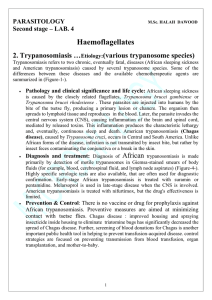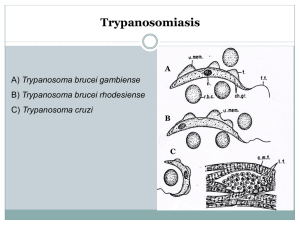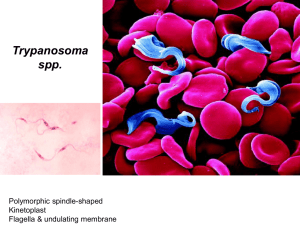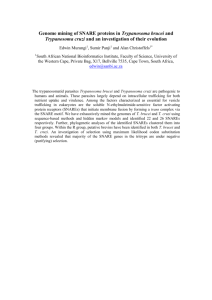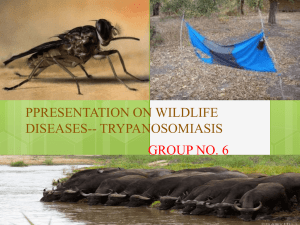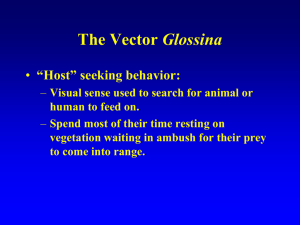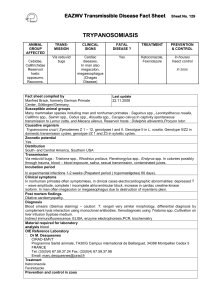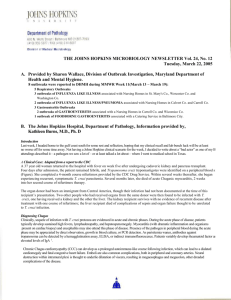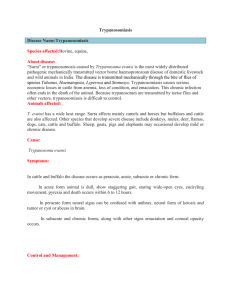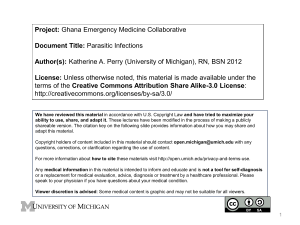Document
advertisement
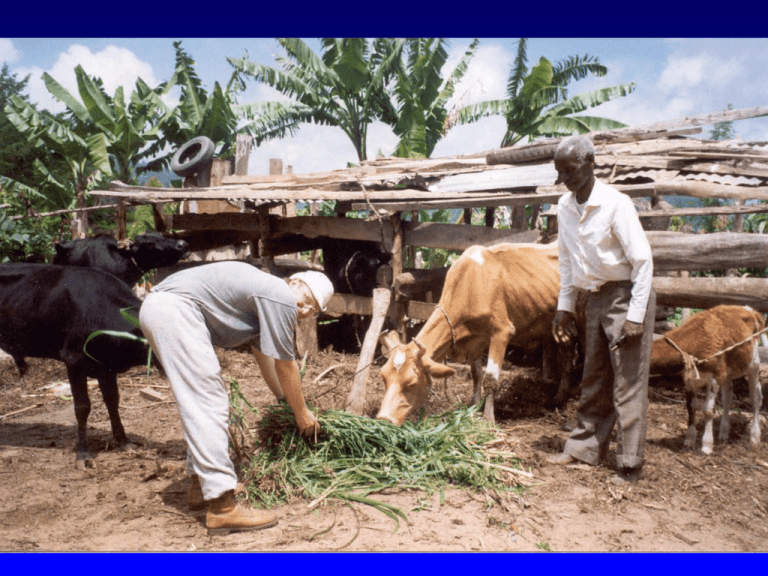
Negative Effects of African Trypanosomiasis • (3) Other: – Presence of tsetse flies have affected the environment. • Pesticides! Negative Effects of African Trypanosomiasis • (3) Other: – Presence of tsetse flies have affected the environment. • Pesticides! – Presence of tsetse flies have affected the climate. • Cattle are underweight. • Many regions have extensive over-grazing. Negative Effects of African Trypanosomiasis • (3) Other: – Presence of tsetse flies have affected the environment. • Pesticides! – Presence of tsetse flies have affected the climate. • Cattle are underweight. • Many regions have extensive over-grazing. – Aesthetics. • How many wild animals can we live with? American Trypanosomiasis • Trypanosoma cruzi: Causative agent of Chagas’ Disease. • Trypanosoma rangeli: non-pathogenic species in humans. T. cruzi T. rangeli Transmission • Transmitted by biting insects in the order Hemiptera. Transmission • Transmitted by biting insects in the order Hemiptera. – Family Reduvidae (Assassin bugs, Reduvids, or Kissing bugs). Transmission • Transmitted by biting insects in the order Hemiptera. – Family Reduvidae (Assassin bugs, Reduvids, or Kissing bugs). – 28 + species however most important are: • • • • Triatoma infestans Triatoma sanguisaga Panstrongylus megistus Rhodnius prolixus • Large up to 34 mm. • Some species found on the ground, some in trees and some in human dwellings. • Eggs, are laid and have 5 nymphal instars. Kissing Bug Feeding on a Person How do People Get Infected? • Epimastigotes are not found in the salivary glands, but instead gather in the rectum of the kissing bugs. How do People Get Infected? • Epimastigotes are not found in the salivary glands, but instead gather in the rectum of the kissing bugs. • In order to get infected epimastigotes must come in contact with mucous membranes or open wound! •Most of these bugs usually defecate at the same time as they are feeding! Main Difference From African Trypanosomiasis • Trypomastigotes do not persist long in the circulatory system and they also do not reproduce there. Main Difference From African Trypanosomiasis • Trypomastigotes do not persist long in the circulatory system and they also do not reproduce there. • Instead they move into muscle cells where they become amastigotes and reproduce by binary fission. 1) *Epimastigotes transmitted through bug feces. 2) Trypomastigotes found in the peripheral blood. 3) Amastigotes reproduce in muscle cells. • In American trypanosomiasis transmission is Stercorarian or Posterior Station! Distribution Primarily in costal areas of US and a few reports in Texas and Arizona! Epidemiology Dogs and Cats can serve as hosts! Dogs and Cats can serve as hosts! Chickens serve as good blood source for bugs! T. cruzi in North America • Sow Why don’t people get infected? Vectors • Triatoma gerstaeckeri • Triatoma sanguisuga Vectors • Feeding habits of T. sanguisuga and T. gerstaeckeri differ from their Latin American counterparts. Vectors • Feeding habits of T. sanguisuga and T. gerstaeckeri differ from their Latin American counterparts. • T. sanguisuga and T. gerstaeckeri are very cautious and neither will walk completely onto a host, reducing the chances of defecating on the host. Vectors • Feeding habits of T. sanguisuga and T. gerstaeckeri differ from their Latin American counterparts. • T. sanguisuga and T. gerstaeckeri are very cautious and neither will walk completely onto a host, reducing the chances of defecating on the host. • Both T. gerstaeckeri and T. sanguisuga generally do not defecate while feeding, reducing fecal contact with the wound even further. • So how do the reservoir hosts become infected? American Trypanosomiasis Course of Infection • There are three phases. American Trypanosomiasis Course of Infection • Phase I. Trypomastigotes in peripheral circulation. – Edema at site of bite (often eye and cheek): if on other area of the body than local inflammation produces a small red nodule (Chagoma) which is a swelling of the regional lymph node. – Headache, fever, prostration. American Trypanosomiasis Course of Infection Romaña’s Sign American Trypanosomiasis Course of Infection • Phase II. Trypomastigotes enter cells. – Symptoms of phase I subside or become absent. American Trypanosomiasis Course of Infection • Phase III. Amastigotes within cells. – Almost any cell can be invaded; however they most commonly invade cells of the reticuloendothelial system in the spleen and liver, and cardiac, smooth and skeletal muscles, additionally the nervous system may be infected. American Trypanosomiasis Course of Infection • Phase III. Amastigotes within cells. American Trypanosomiasis Course of Infection • Phase III. Amastigotes within cells. – Edema: abnormal accumulation of fluid in the tissue spaces (cellular level) – Inflamed lymph glands – Enlarged spleen and liver (hyperplasia) Pathology of Trypanosoma cruzi Chronic phase - occurs in adults. Apex of heart usually becomes very thin. Impulses into ventricles are affected. American Trypanosomiasis Course of Infection • Phase III. Amastigotes within cells. – Heart muscles: • Fibers separated, inflamed • Fibers weakened/ myocardial dysfunction (irregular heartbeat) • Invasion of connective tissue which will cause an enlarged heart • Nerve ganglia destroyed/ cardiac arrest Pathology of Trypanosoma cruzi • Megaesophagus and Megacolon. Pathology of Trypanosoma cruzi • Megaesophagus and Megacolon. • Muscle tone and peristalsis is destroyed. Pathology of Trypanosoma cruzi • Megaesophagus and Megacolon. • Muscle tone and peristalsis is destroyed. • Organs increase their diameters greatly. Pathology of Trypanosoma cruzi • Megaesophagus and Megacolon. • Muscle tone and peristalsis is destroyed. • Organs increase their diameters greatly. • Victim may not be able to swallow and dies from starvation. Pathology of Trypanosoma cruzi • • • • Megaesophagus and Megacolon. Muscle tone and peristalsis is destroyed. Organs increase their diameters greatly. Victim may not be able to swallow and dies from starvation. • Feces not formed effectively. Pathology of Trypanosoma cruzi Diagnosis • Demonstration of trypanosomes in blood, but this is very difficult. • ELISA • Xenodiagnosis Xenodiagnosis Prognosis and Epidemiology • Not Good!! No effective treatment! • 12-19 million people infected in the early 1990’s in Central and South America! • Currently about 25% of people are infected in Latin America! Prognosis • Not all people die from it! • Children have acute cases and within a month die. • Adult infections are more chronic. – Have shorter life span – 30% die!
